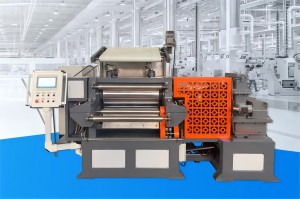
How Twin-Conical Screw Extrusion Calendering Machines Improve Rubber Sheet Quality
2025-11-18
In the earlier blogs, we explored how equipment such as Mixing Mills, Calendering Machines, Rubber Slicing Machines, and Stripping Machines works together to turn raw rubber into stable, consistent sheets.
Now, let’s look at another essential piece of equipment that many manufacturers rely on for higher precision and better efficiency — the Twin-Conical Screw Extrusion Calendering Machine.
This machine bridges the gap between mixing and calendering, offering stable extrusion, excellent plasticizing performance, and accurate sheet formation.
What Is a Twin-Conical Screw Extrusion Calendering Machine?
A Twin-Conical Screw Extrusion Calendering Machine combines two major processes:
-
Extrusion: Using twin-conical screws to push, compress, and plasticize rubber material.
-
Calendering: Using multiple rollers to flatten and shape the rubber into sheets with controlled thickness.
For many readers, the easiest way to imagine this system is:
like sending rubber through a gradually tightening pathway, allowing it to become more uniform and easier to control.
Compared with a traditional single-screw extruder, the conical structure provides better pressure, better mixing, and more stable output.
How the Twin-Cone Structure Works
The twin-conical screw structure gradually compresses the rubber as it moves forward. Temperature, pressure, and density become more stable. This makes the rubber material easier to handle during calendering.
In fact, the rubber is already well-plasticized before entering the rollers. That reduces common problems such as bubbles, uneven surfaces, and irregular thickness. One big advantage is that the material flow rate becomes incredibly consistent — and honestly, this is a game changer for many factories.
Main Advantages Over Traditional Extrusion Systems
✔ More Stable Output
The sheet thickness is more uniform, reducing rejection rates and waste.
✔ Stronger Material Compatibility
This machine handles high-hardness, high-viscosity rubber more easily than standard single-screw systems.
✔ Enhanced Plasticizing
Rubber reaches a better plasticizing state before calendering, improving surface finish and product quality.
✔ Perfect Integration With the Whole Production Line
It can directly connect with Rubber Slicing Machines, Calendering Machines, and Stripping Machines, forming a continuous, automated line.
How It Connects to the Previous Equipment
Previously, we introduced this workflow:
-
The Mixing Mill mixes and softens rubber.
-
The Calendering Machine turns it into sheets.
-
The Rubber Slicing Machine cuts sheets to size.
-
The Stripping Machine refines the surface.
Now, the Twin-Conical Extrusion Calendering Machine fits right into this chain:
This addition makes the entire process smoother and far easier to control. It improves temperature consistency and sheet accuracy before reaching the calender rolls.
Why Manufacturers Switch to Twin-Conical Extrusion
Many factories upgrade to this system because they want:
-
More stable sheet quality
-
Less manual adjustment
-
Better energy efficiency and long-term cost savings
-
Higher automation across the line
For products like sealing materials, conveyor belts, rubber flooring, shoe soles, and industrial rubber sheets, this technology brings significant improvements in uniformity and durability.
And well, let’s be real — any improvement that reduces scrap and keeps the line running smoother is something manufacturers truly love.
Quick Note on Performance
Twin-conical systems are reliable, versatile, and easier to maintain. It deliver stable extrusion that make the overall process more efficient.
The Twin-Conical Screw Extrusion Calendering Machine plays a critical role in producing consistent and high-quality rubber sheets. When working together with Mixing Mills, Slicing Machines, and Stripping Machines, it forms a complete and efficient production line.
In the next article, we will compare Twin-Conical and Triple-Conical screw extrusion systems to help readers understand which configuration fits their production needs better.


